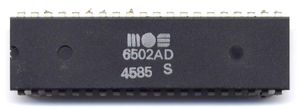There seem to be a number of histories out there that try and paint Microsoft’s Bill Gates and Paul Allen or Apple’s Steves Jobs and Wozniak as the inventors of microcomputing.
 I reckon it couldn’t be farther from the truth. I reckon it was Chuck Peddle.
I reckon it couldn’t be farther from the truth. I reckon it was Chuck Peddle.
Chuck Peddle not only invented the 6502, which cut the cost of microprocessors markedly (making them affordable to people like the Steves to play around with them and put into the Apple) he was also behind the PET, from which the Vic-20 and Commodore 64 were descended.
These were the first computers to sell in their millions, introducing affordable microcomputing to the masses of the western world, and pathing the way for the PCs and Macs you see in homes today. (The Commodore 64 is still the biggest selling computer of all-time, though given the proliferation of PCs, I suppose the comparison is a little unfair.)
And the 6502 went not only into Commodore and Apple machines, but also into Ataris (including the VCS 2600), the BBC Micro, Nintendo NES and many others. It’s said it directly inspired today’s ARM processors (ARM came out of Acorn, the BBC Micro manufacturers) now found in so many consumer electronic devices. (So is the 6502, as it happens.)
Commodore BASIC was bought from Microsoft, making Commodore one of their earliest big customers (though it was a cut-throat deal). Microsoft’s BASIC went into a lot of other computers at the time, and lives-on in Visual Basic, now the most popular programming language on the planet.
As Peddle says in the book I’ve just finished reading (On The Edge — The Spectacular Rise and Fall of Commodore by Brian Bagnall), “We changed the world.” And he’s right.
Unfortunately Commodore’s role in all this tends to get overlooked in many histories, such as Triumph of the Nerds and the like.
Other things I learnt reading the book:
- Jack Tramiel was a ruthless businessman, but he did make this all happen, until he was ousted from Commodore by Irving Gould.
- Irving Gould couldn’t organise a piss-up in a brewery. He and many of his appointments were the epitome of bad management, and what directly drove Commodore to bankruptcy.
- The Commodore marketing department produced some real clangers of promotions, which didn’t properly advertise the great machines at all well.
- Some of the brilliant engineers involved should have been household names, but alas aren’t. That’s the way of the world I suppose.
- The PET had a metal case because Commodore had a file cabinet-making business.
- The C64 had the same case as the Vic-20 because they didn’t have time to build anything else.
- I must have been out of my mind when I bought that Commodore Plus 4 all those years ago. Obviously I couldn’t see it at the time, but it had lemon written all over it.
- The Amiga 1200 I bought in the early 90s was a much better buy. One day I hope I can play the Amiga AGA version of Aladdin again.
- People who are useless are known as human NOPs.
All in all, the book is a great read. Bagnall and his editors apparently don’t know how to use apostrophes, but that doesn’t detract from what is a compelling story. Recommended, especially for anybody who dabbled with computers in the late 70s or 80s.

I’d wondered about those odd metal cases…